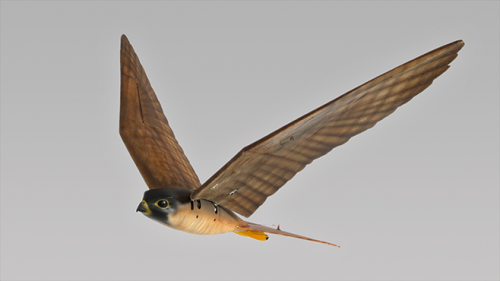September 3, 2014 weblog
3D-printed robotic birds of prey are undergoing trials

Robirds are remotely controlled robotic birds with the realistic appearance and weight of real birds. They were designed to use flapping wing flight for propulsion, with a flight performance comparable to real birds. With that in mind, and one needs little else motivation, viewers are able to enjoy just watching these Robirds, narration-free, cross the sky. The catchphrase from the company behind the birds, the Netherlands-based Clear Flight Solutions, is "We create birds." They are not just making the robots for fun or hobby pursuits; rather, they are addressing the problems of birds and aviation safety. As the company said, it may be marvelous to see birds flying through the skies but they can represent a lot of problems in waste management, agriculture, and aviation, and nothing tops the risks that birds cause at airports, said the company video. The little flyers can put the airplanes and their passengers at risk. The company has designed Robirds to mimic birds of prey, and these keep real birds at bay, with the birds assuming they are being threatened by the real deal. Birds learn to avoid the hunting grounds of the Robird. just as they would real birds posing danger.
"Birds learn to avoid the active hunting grounds of a bird of prey, with bird numbers dropping by as much as 50 percent or more, depending on the location and surroundings. Because the Robirds trigger the instinct of birds, there are no chances of habituation in the long term. There are currently no other means available in battling the nuisance of birds, that have such high success rates as the Robird," said the company. They developed two types of Robirds: the Falcon and the Eagle. Why not use real birds of prey to steer birds away from unwanted places? The company notes it is difficult to use real birds in a safe and efficient way.
Clear Flight Solutions has been at work developing possibilities for automated operations with their Robird models, and have started practical trials with partners. The trials will continue all this year and the first half of 2015, said the group. Results so far are promising. Wired reported that "At one landfill, they've seen a 75 percent decrease in bird visits. The ones that do return have their heads on a swivel."
In creating their product, the company uses a 3D printed body, which comes out of the machine with full falcon colors, modeled after photographs. They use a glass-fiber nylon composite for the body, which keeps it lightweight but rugged. According to Materialise, the bodies are laser-sintered in glass-filled polyamide. "You can crash these things into the ground at 50 km/h and almost nothing will break," said the company's Nico Nijenhuis in Wired. The composite encases a small battery-powered motor to propel the foam wings, said Audubon magazine. "Steered remotely by someone on the ground, robirds soar overhead like elegant toy planes, circling, dipping, and swerving, even in strong winds."
More information: clearflightsolutions.com/
© 2014 Tech Xplore














